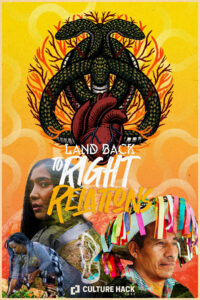Lenses of Indigeneity
These are philosophical and ontological models of the world situated within Indigenous wisdoms and Indigenous knowledge systems which have been in existence for time immemorial. There is a resurgence of young people engaging with their ancestral Indigenous practices in order to resolve modern issues.
Ubuntu
A Nguni Bantu term meaning “I am because we are” and often used to mean “humanity”, it is derived from African cosmologies and reflects human mutuality which contrasts to the widespread individualism present in society. The Ubuntu philosophy promotes the idea of collectivism in that society gives humanity to the human being. It has a political aspect that encourages community equality, propagation of the distribution of wealth and collective responsibility. The spirit of Ubuntu is interdependence, it is reciprocal, it is about shared experience and it is about helping others as well as fostering kindness and care towards each other.
Eco-Swaraj
Eco-swaraj is an ancient Indian philosophy, the term “swaraj” is translated as self-rule and stems from the people making decisions in local assemblies. The term became popular during India’s independence struggles against British colonial rule. The term of swaraj goes further than governance by including the link between the individual and to the community and linking to the ideology of responsibility towards others (including the whole of Nature), and the necessitated spiritual deepening . A number of initiatives fulfill the concept of eco-swaraj in rural and urban contexts, this includes sustainable farming, fisheries and pastoralism, food and water sovereignty, decentralized energy production, direct local governance, community health, alternative learning and education, the localization of economies; gender and caste justice, and rights recognizing the differently abled. These initiatives embody an approach that respects the limits of the earth and the rights of other species.
Mitakuye Oyasin
A simplified translation of this Oceti Sakowin (Lakota/Nakota/Dakota) term is “we are all related”, or “all my relatives” which is not only a perspective or an approach governing action but also a way of seeing and being.
“In Lakota culture, we give thanks, always, for everything. We wake up, greet the morning and give thanks for making it to another sunrise. We look out and give thanks for Unci Maka (earth) and all her beauty.”
Mary Black Bonnet
It is spoken during prayer and ceremony to invite and acknowledge all relatives to the moment. Variations of this saying exist across diverse Indigenous contexts throughout North America. It refers to a way of life which considers all things in the universe and earth being related and sharing the same space. The concept is not in the mainstream and centralized to Indigenous practice.
Inter-being
The concept of interbeing is derived from the Vietnamese term tiep hien which broken down tiep means “being in touch with” and “continuing.” Whilst hien means “realizing” and “making it here and now.” Interbeing is a philosophical approach to life which centers the work of poet Thich Nhat Hanh’s take on whole-systems thinking. ” Everything co-exists with this paper. That is why I think the word interbe should be in the dictionary. ‘To be’ is to interbe. You cannot just be by yourself alone. You have to inter-be with every other thing. This sheet of paper is, because everything else is.”
Interbeing is rising in popularity amongst western Buddhists although the concept goes back to 1987. As a doctrine interbeing is related to the Buddhist doctrine of Dependent Origination, which posits that all phenomena are interdependent. Essentially, whatever is in existence is a result of various factors and conditions created by other phenomena and when these factors and conditions are no longer supporting that existence, the thing ceases to be.
Inuit Qaujimajatuqangit
This is an Inuit phrase that means “Inuit Traditional Knowledge” or “that which Inuit have always known to be true.” It is considered to be a unified system of beliefs and knowledge that is considered characteristic to Inuit culture. This term has been formally adopted by the government of Nunavut. Inuit elders have identified a framework for Inuit Qaujimajatuqangit which embodies four laws or maligait that contribute to living a good life. These are: working for the common good, respecting all living things, maintaining harmony and balance and continually planning and preparing for the future. In addition to these four laws, the Inuit elders have developed four guiding principles in which Inuit Qaujimajatuqangit is rooted and which is crucial for developing Inuit Qaujimajatuqangit in the individual and society.
These principles are:
- Pijitsirniq – the concept of serving
- Aajiqatigiingiq – the concept of consensus decision-making
- Pilimmaksarniq – the concept of skills and knowledge acquisition
- Piliriqatigiingniq – the concept of collaborative relationships or working towards a common purpose
- Avatimik Kamattiarniq – the concept of environmental stewardship6. Qanuqtuurunnarniq – the concept of being resourceful to solve problems.
